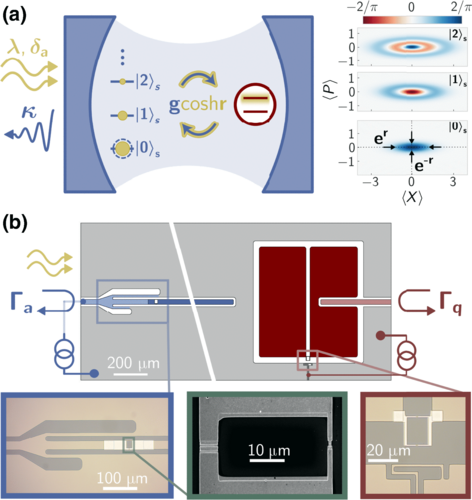Researchers at Laboratoire de Physique de l’Ecole Normale Supérieure Mines Paris Centre Automatique et Systèmes Inria, ENSPSL Université PSL CNRS Sorbonne Université Paris, France, have conducted an experiment that demonstrates the potential for dynamically enhancing qubit-photon interactions with antisqueezing. The team observed a twofold increase in the dispersive interaction between a qubit and an oscillator at 55 dB of squeezing. This could lead to in situ dynamical control of these interactions, pushing weakly coupled systems into the strong coupling regime, and exploring the ultrastrong regime. The findings could have significant implications for the development of quantum technologies.
What is the Impact of Antisqueezing on Qubit-Photon Interactions?
The interaction strength between an oscillator and a qubit increases with the oscillator’s vacuum field fluctuations. This concept has been explored in the context of the degenerate parametric oscillator, which has seen renewed interest due to its potential for strongly detuned squeezing. This process involves amplifying field fluctuations in the antisqueezed quadrature, which can dynamically enhance qubit-photon interactions.
In a recent experiment conducted with a superconducting circuit, a twofold increase in the dispersive interaction between a qubit and an oscillator was observed at 55 dB of squeezing. This demonstrates the potential for in situ dynamical control of qubit-photon interactions. The experiment marks the beginning of coupling oscillators of squeezed photons to qubits, which could have significant implications for experimental platforms seeking enhanced interactions.
The magnitude of an electromagnetic oscillator’s vacuum field fluctuations sets the scale for its coupling strength to a qubit. The value of these fluctuations is directly related to the mode’s impedance and is therefore set by design. For instance, the larger the mode impedance, the stronger its electric field will fluctuate, thus enhancing the coupling to the charge degree of freedom of a qubit. Conversely, the lower the mode impedance, the stronger its magnetic field will fluctuate, thus enhancing the coupling to a spin.
How Can Qubit-Photon Interactions be Enhanced?
Recently, it has been proposed to boost these fluctuations dynamically. This would enable in situ enhancement of qubit-photon interactions with far-reaching applications such as pushing weakly coupled systems into the strong coupling regime, exploring the exotic ultrastrong regime, and observing dynamically activated quantum phase transitions.
The proposals consider a ubiquitous system in quantum optics, the degenerate parametric oscillator, albeit operated in a new regime. In the usual regime, a pump modulates the oscillator frequency at twice its resonance, thus inducing resonant squeezing. However, in the new regime of interest, the pump is far detuned from the parametric resonance. This added detuning renders the system Hamiltonian diagonalizable by a Bogoliubov transformation and is therefore referred to as a Bogoliubov oscillator (BO).
Unlike a regular harmonic oscillator whose eigenstates are circular Fock states, the eigenstates of a BO are squeezed Fock states. Their amplified fluctuations are the root cause for enhancing qubit-photon interactions. Yet they also result in enhanced interactions between the BO and its bath, which are expected to dephase the qubit.
What are the Experimental Observations and Implications?
In a superconducting circuit experiment, it was observed that squeezing a BO amplifies its coupling to a qubit. A twofold increase in the dispersive interaction strength was measured at 55 dB of squeezing. Moreover, it was demonstrated that BOs, through enhanced coupling to their bath, allow for amplification that evades the gain-bandwidth constraint.
These phenomena were observed in a Josephson circuit, for which a rich toolbox of nonlinear dipoles is available to couple low-loss modes. While a regular transmon plays the role of the qubit, implementing a strongly detuned squeezing Hamiltonian without activating spurious nonlinear processes is a technical challenge.
The oscillator frequency was set to ωa2π=6940 GHz, where its decay rate is κ2π=87 MHz. The transmon frequency was set to ωq2π=6840 GHz, where its total linewidth is γt2π=94 MHz and its charging energy is Ech=114 MHz. The resonant coupling rate is g2π=49 MHz.
What is the Future of Qubit-Photon Interactions?
The results of this experiment cautiously motivate the dissemination of oscillators of squeezed photons to qubits in experimental platforms seeking enhanced interactions. The ability to dynamically control qubit-photon interactions could have significant implications for the development of quantum technologies.
The potential for pushing weakly coupled systems into the strong coupling regime, exploring the exotic ultrastrong regime, and observing dynamically activated quantum phase transitions opens up new avenues for research and development in quantum physics and technology.
The experimental coupling of a BO to qubits, which was recently achieved with trapped ions where a phononic BO-mediated amplified qubit-qubit interactions, thereby accelerating a Mølmer-Sørensen gate, further underscores the potential of this approach. As many physical systems interact through their coupling to an electromagnetic field, photonic BOs have raised high expectations but have remained experimentally unexplored until now.
Conclusion
The research conducted by the team at Laboratoire de Physique de l’Ecole Normale Supérieure Mines Paris Centre Automatique et Systèmes Inria, ENSPSL Université PSL CNRS Sorbonne Université Paris, France, has provided valuable insights into the potential for dynamically enhancing qubit-photon interactions with antisqueezing. The experimental results demonstrate the potential for in situ dynamical control of these interactions, opening up new possibilities for the development of quantum technologies.
Publication details: “Dynamically Enhancing Qubit-Photon Interactions with Antisqueezing”
Publication Date: 2024-04-09
Authors: M. Villiers, W.C. Smith, A. Petrescu, A. Borgognoni, et al.
Source: PRX Quantum 5, 020306
DOI: https://doi.org/10.1103/PRXQuantum.5.020306

